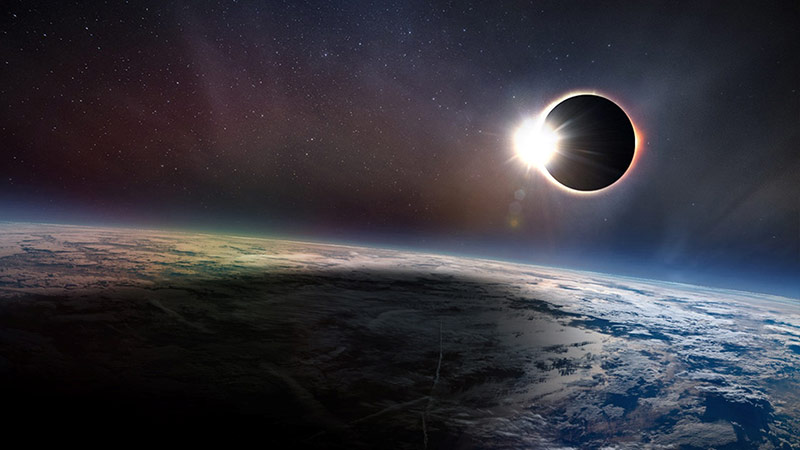Eclipse researchers give N.B. students out of this world education
Author: UNB News
Posted on Apr 4, 2024
Category: Faculty of Science , UNB Saint John , UNB Fredericton

Students and teachers from across New Brunswick are about to get an out of this world education in the unique effects of a total solar eclipse on the Earth’s atmosphere and space environment thanks to a new partnership between the University of New Brunswick (UNB) and public schools across the province.
The UNB Radio and Space Physics Laboratory (RSPL) has helped 15 schools across the province install specialized Global Navigation Satellite Systems (GNSS) receivers to collect atmospheric data during the April 8 eclipse, which will see the path of totality move across a portion of the province.
Antenna are placed on school roofs to monitor perturbations in GNSS satellite signals that result from rapidly changing atmospheric and space weather conditions during the eclipse. Data is recorded by receivers inside the schools, and then relayed back to RSPL servers for analysis.
Educators have been provided with materials to help students learn about scientific research methods, the science and engineering of GNSS, and its application in space physics.
“We wanted to establish a collaboration with provincial schools and provide high school students with an opportunity visit and work with RSPL, with the goal of fostering interest in space science and introducing students to career paths within the Canadian space sector with organizations like UNB, the Canadian Space Agency and Defence Research and Development Canada,” said Anton Kashcheyev, who is leading the school system based EclipseNB project for UNB.
The receivers have been installed in schools across the province, completely free of charge, as a pilot initiative of the pan-Canadian Space Weather Ionospheric Network Canada (SWINCan). Much of the data collected will relate to the ionosphere, the layer of the atmosphere with a high concentration of ions and free electrons capable of disturbing GNSS signals.
Researchers expect to see dramatic changes to the structure and dynamic behaviour of the Earth’s atmosphere and ionosphere due to the sudden reduction in solar radiation within the eclipse path.
With monitoring stations set up in schools from Grand Manan to just outside of Campbellton, some of the receivers will be in the path of totality where the sun will be completely blocked by the moon, others in areas of 90, 80 or 70 percent totality. This dense network data of GNSS receivers will provide measurements of the atmospheric response to the eclipse within and adjacent to the totality path.
In addition to the work with the schools, the outreach team at UNB’s physics department will be working with Science East helping to educate students and the public about the eclipse via science fairs planned for this summer.
“They’re preparing outreach materials looking at issues like what is the effect of the eclipse on signal propagation, in particular GNSS signal propagation,” he said.
He says the exposition will also look at data sets from previous eclipses, to show the effects of the phenomenon.
Inspiring students while collecting valuable scientific information about a once in a lifetime event is just one of the events the UNB Physics Department is participating in.
UNB is also collaborating with the New Jersey Institute of Technology on a working group that is meeting before and after the eclipse. The goal is to gather data and observations to share with the international community.
“The whole purpose is to maximize the potential scientific output and the scientific impact of all the available observations and modelling capabilities for this solar eclipse,” said Chris Watson, who is spearheading UNB’s international approach to the eclipse.
“When you have an eclipse, you get this sudden, localised, atmospheric cooling and depletion in plasma density in the upper atmosphere,” he explained. “Eclipse induced phenomena can include atmospheric gravity waves, ripples in the ionospheric plasma, and even modifications to the near-Earth space environment and the atmosphere at magnetically conjugate locations near Antarctica.”
The EclipseNB network is optimally designed to observe these effects and has garnered international interest.
The totality path on April 8 will span Mexico, USA, and Eastern Canada. As a result of the international working group, RSPL is collaborating with researchers from the international space science and HAM radio communities.
The effects we will see in the atmosphere over New Brunswick are just one element of a complex set of highly connected physical phenomena spanning the Earth’s atmosphere and magnetosphere that will occur during the eclipse. For this reason, there’s a keen interest from the international scientific community to collaborate and share all their observations from around the world.
Being in the path of totality has helped put UNB on the map when it comes to eclipse science and expertise in radio and space physics.
“I’ve gone to a few international conferences and presented the plan for the eclipse observations,” said Watson. “There’s been significant interest, and it’s a good opportunity for UNB to build these international collaborations not only for the eclipse, but for other scientific endeavours moving forward.”
